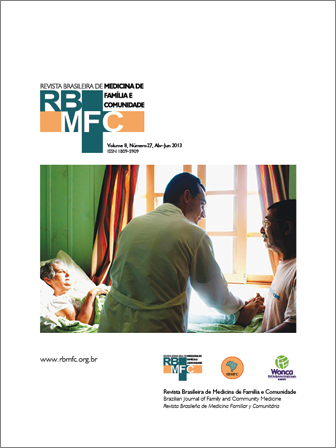Assessment of pre-test probability in Primary Health Care using the International Classification of Primary Care - 2 (ICPC-2)
DOI:
https://doi.org/10.5712/rbmfc8(27)713Keywords:
Primary Health Care, Family Practice, Classification, Episode of CareAbstract
Introduction: The assessment of the patient’s reason for encounter using the International Classification of Primary Care (ICPC) is not common in countries without a strong primary health care system. Objective: This study aimed to evaluate the main reasons for encounter and to calculate the pre-test probabilities for frequent problems. Method: A questionnaire was created to study, in each appointment, the reasons for encounter and the clinical problems (or diagnosis). In total, 26 general practitioners of the Family Health Strategy from the municipality of Florianópolis filled the form after appointments, for four weeks over a year. Results: 5,698 encounters were evaluated, with regular distribution among seasons. There were 1,625 reasons for encounter and 1,475 clinical problems per appointment. The 30 most common clinical problems represented 50% of all appointments, covering 13 different chapters of ICPC-2. Patients with fever as symptom had diagnosis of acute upper respiratory infection (37.7%), acute tonsillitis (17.8%) or fever (11%), while patients who received the diagnosis of acute upper respiratory infection had complained of cough (24.2%), fever (22%) or of a throat symptom/complaint (9.8%). Discussion: Episode of care is the best methodology to assess pre-test probability longitudinally. However, it was possible to estimate the pre-test probability by using the data of each encounter, as demonstrated in the case of fever and acute upper respiratory infection, in spite of its follow up limitation, as it was based on encounters. Conclusion: This study shows that plans for continuing professional development should be focused on common symptoms and diagnosis, in order to improve the clinical reasoning guided by studies of pre-test probabilities. Hence, the ICPC-2 as a classification system is a great contribution to transform any health center in a research center, even those in rural areas of low-income countries.
Downloads
Metrics
References
World Organization of National Colleges, Academies – WONCA, Academic Associations of General Practitioners. Family Physicians (WONCA). Classification Committee. International Classification of Health Problemas in Primary Care (ICHPPC-2-Defined). 3nd ed. Oxford: Oxford University Press; 1983
Crombie DL. Diagnostic Process. J. Coll. Gen. Practit. 1963; 6: 579-89.
White K. Introduction 3. In: World Organization of National Colleges, Academies – WONCA, Academic Associations of General Practitioners. Family Physicians (WONCA). Classification Committee. International Classification of Health Problemas in Primary Care (ICHPPC-2-Defined). 2nd ed. Oxford: Oxford University Press; 1979.
World Organization of National Colleges, Academies – WONCA, Academic Associations of General Practitioners. Family Physicians (WONCA). Classification Committee. International Classification of Primary Care (ICPC-2-R). 2nd ed. rev. Oxford: Oxford University Press; 1998.
Instituto Brasileiro de Geografia e Estatística – IBGE. [homepage on the Internet]. [cited 2008 Out 24]. Disponível em: http://www.ibge.gov.br/home/estatistica/populacao/censo2000/universo.php?tipo=31&paginaatual=1&uf=42&letra=F.
Florianópolis. Prefeitura Municipal. Secretaria Municipal de Saúde. [homepage on the Internet] [cited 2007 Jun 14]. Disponível em: http://www.pmf.sc.gov.br/saude/.
Brasil. Ministério da Saúde. Secretaria de Atenção à Saúde. Departamanto de Atenção Básica - DAB [homepage na Internet] [cited 2007 Jun 14]. Disponível em: http://dtr2004.saude.gov.br/dab/localiza/localiza_cadastro_ret.php.
Biblioteca Virtual em Saúde. Descritores em Ciências da Saúde [homepage on the Internet]. [cited 2011 Aug 11]. Disponível em: http://decs.bvs.br/cgi-bin/wxis1660.exe/decsserver/?IsisScript=../cgi-bin/decsserver/decsserver.xis&interface_language=p&previous_page=homepage&previous_task=NULL&task=start.
Google. Ferramenta de Idiomas [homepage on the Internet]. [cited 2011 Aug 11]. Disponível em: http://www.google.com.br/language_tools?hl=pt-BR.
Okkes IM, Oskam SK, Van Boven K, Lamberts H. EFP. Episodes of care in Dutch Family Practice. Epidemiological data based on the routine use of the International Classification of Primary Care (ICPC) in the Transition Project of the Academic Medical Center/University of Amsterdam (1985-2003). In: Okkes IM, Oskam SK, Lamberts H. ICPC in the Amsterdam Transition Project. Amsterdam: Academic Medical Center/University of Amsterdam, Department of Family Medicine; 2005. CD-Rom.
Britt H, Miller GC, Knox S, Charles J, Pan Y, Henderson J, et al. General practice activity in Australia 2004-05. Canberra: Australian Institute of Health and Welfare; 2005.
Britt H, Miller GC, Charles J, Henderson J, Bayram C, Harrison C, et al. General practice activity in Australia 1998-99 to 2007-08: 10 year data tables. General practice series no. 23. Cat. no. GEP 23. Canberra: Australian Institute of Health and Welfare; 2008.
Weed LL. Medical records, medical education and patient care. Cleveland: Case Western Reserve University Press; 1969.
Weed LL. Medical records that guide and teach. N Engl J Med. 1968; 278: 593-600, 652-7. http://dx.doi.org/10.1056/NEJM196803142781105
Kloetzel K. O Diagnóstico Clinico: Estratégias e Táticas. In: Duncan BB, Schmidt MI, Giugliani ERJ. Medicina Ambulatorial: Condutas de Atenção Primária Baseadas em Evidências. Porto Alegre: Artmed Editora; 2004. p. 131-42.
Stewart M, Brown JB, Weston WW, McWhinney IR, McWilliam CL, Freeman TR. Patient Centered Medicine: Transforming the Clinical Method. 2nd. Abingdon, Radcliffe Medical Press; 2003.
Machado MH, coordenador. Perfil dos médicos e enfermeiros do PSF no Brasil e Grandes Regiões: relatório final. Brasília: Ministério da Saúde; 2000.
Takeda S. A organização de serviços de Atenção Primária à Saúde. In: Duncan BB, Schmidt MI, Giugliani ERJ. Medicina Ambulatorial: Condutas de Atenção Primária Baseadas em Evidências. Porto Alegre: Artmed Editora; 2004. p. 76-87.
Downloads
Published
How to Cite
Issue
Section
License
By submitting a manuscript to the RBMFC, authors retain ownership of the copyright in the article, and authorize RBMFC to publish that manuscript under the Creative Commons Attribution 4.0 license and identify itself as the vehicle of its original publication.















